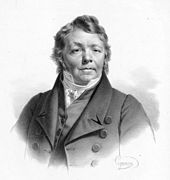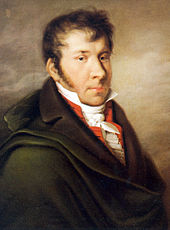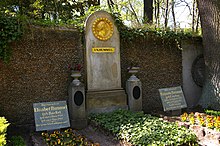Johann Nepomuk Hummel

Johann Nepomuk Hummel (November 14, 1778 – October 17, 1837) was an Austrian composer and virtuoso pianist. His music reflects the transition from the Classical to the Romantic musical era.
Life
Hummel was born in Pressburg, Kingdom of Hungary, then a part of the Austrian Habsburg Monarchy (now Bratislava in Slovakia). His father, Johannes Hummel,[1] was the director of the Imperial School of Military Music in Vienna and the conductor there of Emanuel Schikaneder's theatre orchestra at the Theater auf der Wieden; his mother, Margarethe Sommer Hummel, was the widow of the wigmaker Josef Ludwig. He was named after St John of Nepomuk. Wolfgang Amadeus Mozart offered the boy music lessons at the age of eight after being impressed with his ability. Hummel was taught and housed by Mozart for two years free of charge and made his first concert appearance at the age of nine at one of Mozart's concerts.
Hummel's father then took him on a European tour, arriving in London where he received instruction from Muzio Clementi and staying there for four years before returning to Vienna. In 1791, Joseph Haydn, who was in London at the same time as young Hummel, composed a sonata in A flat for Hummel, who gave its first performance in the Hanover Square Rooms in Haydn's presence. When Hummel finished, Haydn reportedly thanked the young man and gave him a guinea.

The outbreak of the French Revolution and the following Reign of Terror caused Hummel to cancel a planned tour through Spain and France. Instead, he returned to Vienna, giving concerts along his route. Upon his return to Vienna he was taught by Johann Georg Albrechtsberger, Joseph Haydn, and Antonio Salieri.
At about this time, young Ludwig van Beethoven arrived in Vienna and himself took lessons from Haydn and Albrechtsberger, thus becoming a fellow student and a friend. Beethoven's arrival was said nearly to have destroyed Hummel's self-confidence, though the latter recovered without much harm. The two men’s friendship was marked by ups and downs, but developed into reconciliation and mutual respect. Hummel visited Beethoven in Vienna on several occasions with his wife Elisabeth and pupil Ferdinand Hiller. At Beethoven's wish, Hummel improvised at the great man's memorial concert. It was at this event that he made friends with Franz Schubert, who dedicated his last three piano sonatas to Hummel. However, since both composers had died by the time of the sonatas' first publication, the publishers changed the dedication to Robert Schumann, who was still active at the time.
In 1804, Hummel became Konzertmeister to Prince Esterházy's establishment at Eisenstadt. Although he had taken over many of the duties of Kapellmeister because Haydn’s health did not permit him to perform them himself, he continued to be known simply as the Concertmeister out of respect to Haydn, receiving the title of Kapellmeister, or music director, to the Eisenstadt court only after the older composer died in May 1809. He then remained in the service of Prince Esterházy for seven years before being dismissed in May 1811 for neglecting his duties.[2] He then returned to Vienna where, after spending two years composing, he married the opera singer Elisabeth Röckel in 1813. The following year was at her request spent touring Russia and the rest of Europe. The couple had two sons.[3]
Hummel later held the positions of Kapellmeister in Stuttgart from 1816 to 1819 and in Weimar from 1819 to 1837, where he formed a close friendship with Goethe, learning among other things to appreciate the poetry of Schiller, who had died in 1805. During Hummel's stay in Weimar he made the city into a European musical capital, inviting the best musicians of the day to visit and make music there. He brought one of the first musicians' pension schemes into existence, giving benefit concert tours when the retirement fund ran low. Hummel was one of the first to agitate for musical copyright in order to combat intellectual piracy. In 1832, at the age of 54 and in failing health, Hummel began to devote less energy to his duties as music director at Weimar. In addition, after Goethe’s death in March 1832 he had less contact with local theatrical circles and as a result found himself in partial retirement from 1832 until his death in 1837.[3]
Influence

While in Germany, Hummel published A Complete Theoretical and Practical Course of Instruction on the Art of Playing the Piano Forte (1828), which sold thousands of copies within days of its publication and brought about a new style of fingering and of playing ornaments. Later 19th century pianistic technique was influenced by Hummel, through his instruction of Carl Czerny who later taught Franz Liszt. Czerny had transferred to Hummel after studying three years with Beethoven.
Hummel's influence can also be seen in the early works of Frédéric Chopin and Robert Schumann, and the shadow of Hummel's Piano Concerto in B minor as well as his Piano Concerto in A minor can be particularly perceived in Chopin's concertos. This is unsurprising, considering that Chopin must have heard Hummel on one of the latter's concert tours to Poland and Russia, and that Chopin kept Hummel's piano concertos in his active repertoire. Harold C. Schonberg, in The Great Pianists, writes "the openings of the Hummel A minor and Chopin E minor concertos are too close to be coincidental".[4] In relation to Chopin's Preludes, Op. 28, Schonberg says: "It also is hard to escape the notion that Chopin was very familiar with Hummel's now-forgotten Op. 67,[5] composed in 1815 – a set of twenty-four preludes in all major and minor keys, starting with C major".
Robert Schumann also practised Hummel (especially the Sonata in F-sharp minor, Op. 81), and considered becoming his pupil. Liszt's father Adam refused to pay the high tuition fee Hummel was used to charging (thus Liszt ended up studying with Czerny). Czerny, Friedrich Silcher, Ferdinand Hiller, Sigismond Thalberg, and Adolf von Henselt were among Hummel's most prominent students. He also briefly gave some lessons to Felix Mendelssohn.[6]
Music

Hummel's music took a different direction from that of Beethoven. Looking forward, Hummel stepped into modernity through pieces like his Sonata in F-sharp minor, Op. 81, and his Fantasy, Op. 18, for piano. These pieces are examples where Hummel may be seen to both challenge the classical harmonic structures and stretch the sonata form.
His main oeuvre is for the piano, on which instrument he was one of the great virtuosi of his day. He wrote eight piano concertos, ten piano sonatas (of which four are without opus numbers, and one is still unpublished), eight piano trios, a piano quartet, a piano quintet, a wind octet, a cello sonata, two piano septets, a mandolin concerto, a mandolin sonata, a Trumpet Concerto in E major written for the Keyed trumpet (usually heard in the more convenient E-flat major), a "Grand Bassoon Concerto" in F, a quartet for clarinet, violin, viola, and cello, four hand piano music, 22 operas and Singspiels, masses, and much more, including a variation on a theme supplied by Anton Diabelli for Part II of Vaterländischer Künstlerverein.
Although thought of in terms of the piano in modern times, Hummel was seriously and constantly interested in the guitar, and he was talented with the instrument. He was prolific in his writing, and his compositions for it begin with opus 7 and finish with opus 93. Other guitar works include Opp. 43, 53, 62, 63, 66, 71 and 91, which are written for a mixture of instruments.[7]
Hummel's output is marked by the conspicuous lack of a symphony. Of his eight piano concertos the first two are early Mozartesque compositions (S. 4/WoO 24 and S. 5) and the later six were numbered and published with opus numbers (Opp. 36, 85, 89, 110, 113, and posth 1).
A full list of Hummel's works is available online.[8]
Last years and legacy

At the end of his life, Hummel saw the rise of a new school of young composers and virtuosi, and found his own music slowly going out of fashion. His disciplined and clean Clementi-style technique, and his balanced classicism, opposed him to the rising school of tempestuous bravura displayed by the likes of Liszt. Composing less and less, but still highly respected and admired, Hummel died peacefully in Weimar in 1837. A freemason (like Mozart), Hummel bequeathed a considerable portion of his famous garden behind his Weimar residence to his masonic lodge. His grave is in the Historical Cemetery, Weimar.
Although Hummel died famous, with a lasting posthumous reputation apparently secure, his music was quickly forgotten at the onrush of the Romantic period, perhaps because his classical ideas were seen as old-fashioned. Later, during the classical revival of the early 20th century, Hummel was passed over. Like Haydn (for whom a revival had to wait until the second half of the 20th century), Hummel was overshadowed by Mozart. Due to a rising number of available recordings and an increasing number of live concerts across the world, his music is now becoming reestablished in the classical repertoire.
Notes
- ^ Hust, Christoph. 2003. "Hummel, Johann Nepomuk." In: Musik in Geschichte und Gegenwart. 2nd ed. Ludwig Finscher (ed.). Kassel: Bärenreiter, pp. 503–511.
- ^ Cummins, Robert. Piano Sonata No. 3 in F minor, Op. 20 at AllMusic. Retrieved 27 September 2012.
- ^ a b Cummins, Robert. Johann Nepomuk Hummel at AllMusic. Retrieved 27 September 2012.
- ^ Harold C. Schonberg, The Great Pianists, p. 110
- ^ Scans from Universal Edition c. 1900, and symbolic data for Op. 67 preludes
- ^ Joel Sachs, Hummel, Johann Nepomuk, §6 "Performance and teaching", Oxford Music Online (subscription only), accessed 29 May 2011
- ^ Philip J. Bone, The Guitar and Mandolin, biographies of celebrated players and composers for these instruments, London: Schott and Co., 1914.
- ^ Hummel's All Works Catalog (PDF), retrieved 16 October 2011, compiled and formatted by Mr. Mikio Tao of Japan. His sources were The New Grove Dictionary of Music and Musicians, as well as Dieter Zimmerschied's Thematisches Verzeichnis der Werke von Johann Nepomuk Hummel
References
- Johann Nepomuk Hummel: Der Mensch und Künstler. Karl Benyovszky, Breslau: Eos-Verlag 1934.
- Zwischen Klassik und Klassizismus. Johann Nepomuk Hummel in Wien und Weimar. Anselm Gerhard, Laurenz Lütteken (editors), Kassel: Bärenreiter 2003.
- Kroll, Mark (2007). Johann Nepomuk Hummel: A musician's Life and World. Lanham, MD: Scarecrow Press. ISBN 0-8108-5920-3.
- Lorenz, Michael: "Maria Eva Hummel. A Postscript", Vienna 2013
- Schonberg, Harold C. (1963). "VII: From Ireland to Bohemia". The Great Pianists: From Mozart to the Present. New York: Simon & Schuster.
- Schonberg, Harold C. (1987). The Great Pianists (Rev. & updated ed.). New York City: Simon and Schuster. ISBN 0-671-64200-6.
- Kapellmeister Hummel in England and France. Joel Sachs, Detroit: Information Coordinators 1977.
- Johann Nepomuk Hummel und Weimar. Komponist, Klaviervirtuose, Kapellmeister 1778–1837. Kurt Thomas, Weimar: Rat der Stadt 1987
- Die Kammermusik Johann Nepomuk Hummels. Dieter Zimmerschied, Mainz: 1966.
- Thematisches Verzeichnis der Werke von Johann Nepomuk Hummel. Dieter Zimmerschied, Hofheim am Taunus: Hofmeister 1971.
External links
- The Hummel Project Comprehensive website on the life and works of Hummel including biographical information, videos, audio samples and scores along with information on performances of Hummel's work in the UK and France
- Hummel Gesellschaft Weimar Official Home Page of the Hummel Society in Weimar (German)
- Hummel's House in Marienstrasse 8, Weimar Official website of the Hummel House (owned by the Lückhoff Institute)
- Classical composers database entry
- Short biography
- 8notes biography and commentary
- Haydn Page with reference to Hanover Square Rooms performance
- Compactdiscoveries article on Hummel's relation to Chopin
- Karadar.com Biography with free MP3s recorded by themselves
- Hummel on Hyperion Records; many of the individual CD pages have a further link to sound samples and/or the CD booklet notes.
- Hummel medallion by David d'Angers, 1834.
- Johann Nepomuk Hummel Discussion Group on Yahoo
- Septet, Op. 74, recording by ensemble Solstice
Music scores
- Free scores by Johann Nepomuk Hummel at the International Music Score Library Project (IMSLP)
- Free scores by Johann Nepomuk Hummel in the Choral Public Domain Library (ChoralWiki)
- Classical-period composers
- Romantic composers
- Austrian composers
- German composers
- Austrian classical pianists
- Hungarian classical pianists
- Austrian people of Hungarian descent
- Hungarian-German people
- People from Bratislava
- 1778 births
- 1837 deaths
- 18th-century Austrian people
- 18th-century German people
- Honorary Members of the Royal Philharmonic Society
- Composers for piano
- Composers for the classical guitar
- Hungarian guitarists
